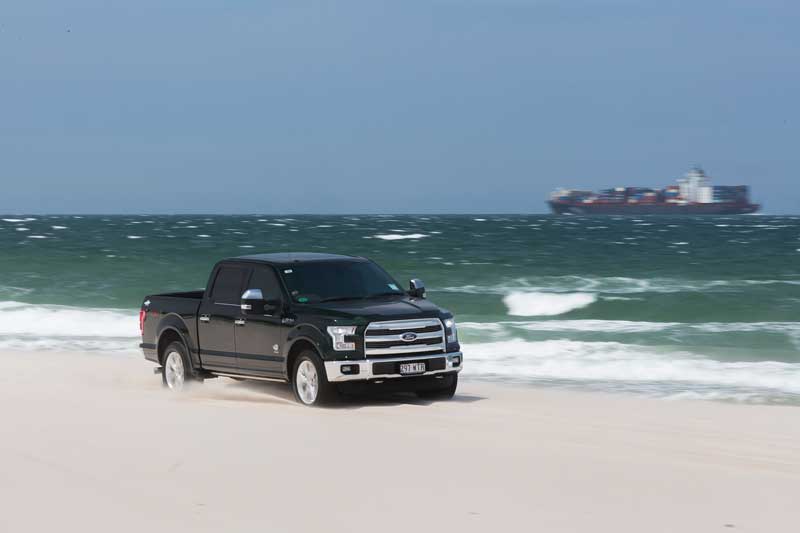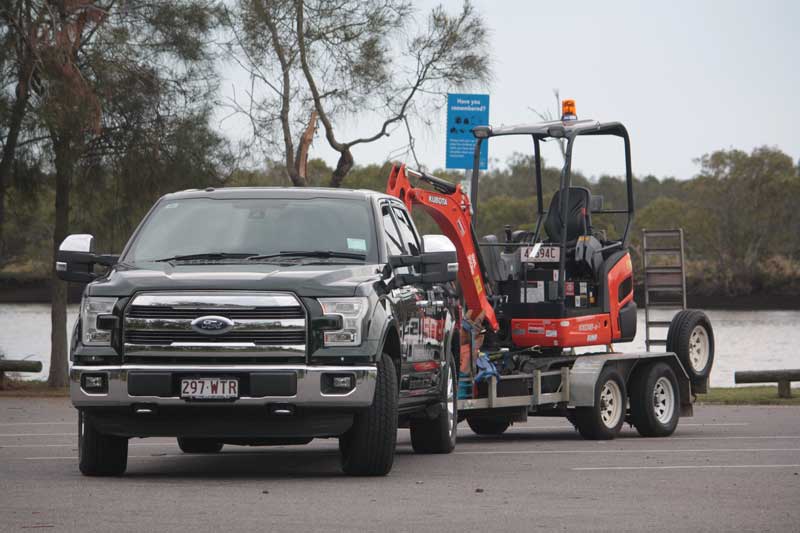Even Yank Tanks are being affected by engine downsizing. Matt Wood pits the aluminium-bodied Ford F150 V8 truck against the sensitive new-age EcoBoost V6 version.
Ford’s ‘EcoBoost’ badge doesn’t exactly conjure up flattering commentary with a lot of Aussie punters.
For some it was the abomination (yet actually quite effective) 4-cylinder engine that was slotted between the guards of the now defunct Falcon. For others it’s the povvo power plant option for the current-model Mustang.
I’m sure the name is meant to conjure up images of power and social responsibility; it’s meant to be the thinking person’s donk.
 |
|
The F-150’s long wheelbase makes it a comfortable cruiser on and off road
|
Six of the best
So when Ford decided to launch a range of EcoBoost engines for its US-market-dominating F-150, you’d be forgiven for thinking that the company was on a hiding to nothing.
For six decades, the Effie has had a tradition of bent-eight propulsion and, on top of this, the F-150 has been the biggest-selling vehicle in the US for nearly four decades. There was a lot at stake.
The premium EcoBoost engine for the Effie is a 3.5-litre twin-turbo V6. After its US launch it was very nearly a flop until Ford found a way of piping a V8 burble into the cab via the Bose sound system.
Interestingly this worked, and the V6 engine has become the most popular option for the all-aluminium-bodied F-truck in the States.
So I grabbed the key fob to a couple of the latest petrol-fuelled examples of the F-150 4×4, one powered by the 5-litre Coyote V8, the other powered by the 3.5-litre dual-overhead-cam twin-turbo EcoBoost V6.
The 2016 models featured here both use Ford’s 6R80 auto trans. From 2017, EcoBoost-powered trucks will also get a 10-speed auto.
Both of these trucks came via Harrison F-Trucks and sport right-hand drive conversions by Melbourne-based VDC. Harrisons and VDC only deal with Ford products, and VDC has Ford-approved modification status.
8-iron soundtrack
Descending into the posh leather of my maroon V8 King Ranch Effie did raise a smile to my dial. But nothing gets a grin as much as the rumble of the Coyote under the bonnet.
The naturally aspirated burble drifting from the exhaust pipe tips quickly builds to a satisfying crescendo when the hoof is buried. It’s an addictive soundtrack.
The premium King Ranch badge gets a whole cow herd of leather, massive sunroof, and a raft of driver-assist aids, including adaptive cruise control, lane departure warning, trailer sway assist, hill-start assist, yada yada yada …
A 360-degree camera displays a bird’s-eye view of the truck’s surroundings while parking or squeezing into tight spaces.
If you’re at all paranoid about big brother watching from the sky, this feature may be a little unnerving, but no, the guv’mint ain’t watching you park. The display is made up of data picked by cameras dotted around the truck.
Given the dimensions of the F-Truck, it’s a handy feature both in town and out in the bush.
Cheating in reverse
For those who aren’t real flash at reversing a trailer, there’s also a neat Pro Trailer Backup Assist function that lets you program where your trailer needs to be slotted in. The pick-up will then automatically steer it into place, much like an auto-park function – which, I might add, the King Ranch F-150 also has.
The 385hp 5-litre does its best work with the tacho above 3500rpm. It not only sounds hilarious, it hauls. Peak power from the 8-iron is at 5750rpm and peak torque (525Nm) is at 3850rpm.
Kick the Go pedal under load and the 5-litre emits a howl that sounds like Chewbacca being kicked in the goolies.
Compared to its bigger Super Duty siblings, the 150 is a whole lot more nimble on the open road; the IFS front end and leaf sprung rear are still quite civilized when the truck is empty.
 |
|
There’s more cow skin in here than an Indonesian abattoir
|
Plush yet ballsy
Considering this is also a $150k-plus vehicle, it’s every bit as cosseting as you expect … for a truck.
Payload for this Effie is a fairly modest 850kg, especially considering the not-so-slight proportions of the Ford. But braked towing capacity with a 70mm ball is 4000kg. And while these 4×4 pick-ups are pretty capable off-road, towing is really what these trucks are about.
We hooked a pretty hefty tri-axle trailer and a load of wood behind the 150, and the result was predictable. With 2500kg on its back, the rear end barely noticed the load. (Again, the V8 still needs to be revving to get its boogie on.)
The 6-speed auto trans is an intuitive unit and will downshift under brakes. The Ford also comes with electric trailer brakes as standard.
Off road, the 150’s shift-on-the-fly 4×4 system is easy to use and intuitive. There are few surprises here, with hill descent control, traction control and a rear-diff lock as standard kit.
As a bush basher, the Effie is a little wide if you want to keep the shiny bits unscratched. But, in open country and on the beach, the V8 Ford is quite a capable performer, though I doubt the aluminium body panels would take much punishment from sticks, branches and rocks.
Downsizing
After the petrol-headed hoonery of the V8, I was somewhat dubious about the EcoBoost Effie. My green steed was almost identical in spec to the maroon V8 machine, save the smaller engine.
The automatic side steps remained a novelty that dropped from the body of the truck when the doors were opened. The big kid in me loves them.
The fake engine rumble inside the V6 F-150 is nearly almost convincing. But the engine note outside the Ford is more angry taxi than howling muscle car.
Performance wise, though, there’s certainly nothing to complain about.
The V6 makes slightly less power than the V8: 365hp versus 385hp. But it makes more torque and delivers it much lower in the rev range. The 570Nm of twisty force is on tap from 2500rpm courtesy of its twin low-inertia turbos. That’s more than 1000rpm lower than the eight-iron.
The result is a much more flexible engine both off road and when towing.
The V8 needs a boot full of revs to get cracking and can quickly bury itself in sand and muck with its abrupt, peaky power delivery. The EcoBoost, however, calmly unfurls power and torque with much more manageable finesse. In fact, the only time I got stuck on the beach at Bribie was the photographer’s fault. But, then again, everything is always the photographer’s fault!
A quick flick through the Kennards Hire website landed me a plant trailer and a gross tow load of just over 2500kg. Under load the tacho needle rarely exceeded 3000rpm. It was effortless where the V8 was entertaining. The Effie’s outboard rear shocks reduce any squirm under load.
 |
|
The EcoBoost V6 is the tow engine of choice; it makes more torque at lower rpm than the V8
|
Big footprint
The King Ranch’s 20-inch alloy wheels aren’t the most practical items off road either, but romping along the beach still proved a walk in the park for the 6-pack-equipped 150. Even in summer’s soft sand conditions, the flexible power delivery of the EcoBoost made it very easy to live with. The Effie’s big footprint helps it float over ruts with ease.
Ford’s competitors have had quite a bit of fun demonstrating how easy it can be to bang up the ally tub back home. In Australian terms, however, nobody is likely to be dropping bucketloads of bricks into the back of an expensive truck like this. A tub liner wouldn’t go astray anyway.
It’s a tow machine first and foremost and, in a 150, the tub is more likely to be a big boot than a heavy load space.
The only steel parts of an F-150 these days are the chassis, firewall and driveline components. It may look like a heavy, blunt object but it’s deceptively nimble in operation.
This year the Effie is also set to get a diesel option for the first time. And the aluminium construction is also now extending into the Super Duty range.
There’s no doubt smart money is on the V6 F-150 as a tow engine. Its torque output and power delivery makes it an effortless hauler. It’s easy to see why the EcoBoost power plant has become so popular in the US. It’s also the easiest engine to live with off road and it uses less juice.
The sensible decision
The trouble is I just can’t pass up the Coyote; it just makes the Ford so much fun on and off road. Which is probably why I should never be allowed to make purchasing decisions like this.
The Raptor, Ford’s off-road 4×4 hottie, has also dropped the 5-litre in favour of the Ecoboost V6. And it’s the engine of choice for Ford’s carbon-fibre GT Le-Mans car.
Buying a new Effie may be a wallet-melting experience, but these things will tow 3.5 tonnes all day on their ear. Consider that in ute terms – there’s nothing else on the Aussie market aside from a 70 series Cruiser or a light truck that has the GCM to tow and haul at the same time.
If you want to haul that sort of weight big distances in luxury you’re limited to the 200 Series Land Cruiser or a Land Rover Discovery, though Nissan’s petrol-powered Y62 Patrol should also rate a mention. A big yank pick-up gives you the best of both worlds.
Fuel DuelA combination of on road, off road and towing had us watching fuel economy of both engines. The V8 still returned a very respectable 15.3L/100km, especially considering my heavy right foot. The V6, however, returned an excellent 13.4L/100km over urban, highway, towing and beach usage. It’s also worth noting that, according to Ford’s performance figures, the V6 is faster to 100km/h than the V8: 5.8 seconds versus 6.3. |
SPECS
Ford F-150 King Ranch V8
Engine: Dual overhead cam naturally aspirated 5-litre V8
Fuel: Unleaded
Power: 288kW
Torque: 525Nm@3850rpm
Transmission: 6-speed automatic
Drive: Part time 4×4, 2-speed transfer case
Payload: 850kg
Towing: 4000kg (braked)
Warranty: Four years/130,000kms
Price as tested: $150,000 (plus on-roads) *exchange rate dependent
Ford F-150 King Ranch EcoBoost V6
Engine: Dual overhead cam twin-turbo V6
Fuel: Unleaded
Power: 272kW
Torque: 570Nm@2,500rpm
Transmission: 6-speed automatic
Drive: Part-time 4×4, 2-speed transfer case
Payload: 850kg
Towing: 4000kg (braked)
Warranty: Four years/130,000km
Price as tested: $153,000 (plus on-roads) *exchange rate dependent







